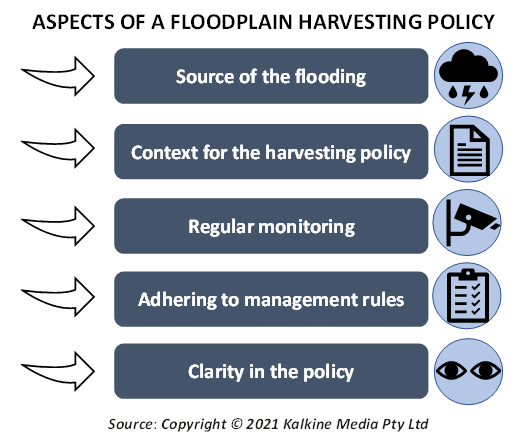What is the Floodplain Harvesting?
Floodplain harvesting refers to the practice of capturing flood water that has flown into the plains due to rainfall for later use. It occurs during the rainy season when a large amount of water flows into the floodplains. This water is made use of with the help of dams and other engineered structures.
Long and low engineered structures like access roads, channels, and levee banks are used to access the water that is running across. This water is diverted and flown downstream or soaked into aquifers. After that, the water is soaked stored in on-farm dams or in off-river storages which can be considerable in size.
Water that has been collected in the plains is extracted to be used for irrigation in farming. However, the process of floodplain harvesting requires a robust and detailed framework for the licensing of the process.
Despite the advantages offered by floodplain harvesting it continues to remain a topic worth debating. The issue has been received with divided opinions with some feeling the process is an act of theft from the environment.
How is a floodplain harvesting policy carried out?
Any floodplain harvesting policy must be made keeping in mind the following points:
- Source: Mentioning the source is of utmost importance as it determines whether floodplain harvesting is the right course of action or not. Flood plain harvesting works are designed keeping in mind that the collected water has overflown from the riverbanks and not from any other source.
This is important in cases where the water is being collected because of excessive rainfall. In such a scenario, the works designed to capture the water would be different from those designed to divert water overflowing the banks. Thus, segregating rainfall harvesting from floodplain harvesting is an integral part of such a policy.
Segregating based on the source of water is a tough task. The appropriate measure in such a case is looking back at previous records of floods in a particular area. Historical records can provide an estimate of how much amount of water is collected as the result of floods.
- Context: For any policy to be considered, it is important to set the perfect grounds on which the policy would be based. Setting up a reasonable explanation as to why the policy is required is an issue of prime concern for any policymaker.
The overall context is imperative to set up an area for discussion. There may be instances when floodplain harvesting might not be the possible course of action. More information may be required to list out the perfect engineering method required to facilitate the extraction. Therefore, as much data should be provided as can be managed through historical records.
- Monitoring: Once the tools are set up, they must be monitored regularly to check for anomalies. However, the process of monitoring is very complex and involves different channels. Thus, monitoring includes checking various parameters like the volume of water that has flown into the plains, protecting nearby vegetation etc.
Governments may also require the concerned party to find alternatives to conventional methods of monitoring. Some such techniques include remote sensing, LiDAR to determine the path of water flows and storage columns.
- Accounting for management rules for floodplain harvesting: There is a scarcity of data pertaining to the level of water that can be extracted from the floodplains during different flooding periods. This data is important in achieving certain government mandated guidelines.
Finding out tools and measurements that can be used universally across all plains is also essential. Additionally, all floodplain harvesting works must be licensed and metered. More sound knowledge about technology is required as there is not enough data to work with in the domain of floodplain harvesting.
- Clarity: It is imperative to have clear definition of structures and floodplain harvesting into the policy made by governments.

What are the Challenges facing floodplain harvesting?
There are many living organisms that thrive on riverbanks are exposed to a threat due to floodwater harvesting. Many organisms and ecological processes derive benefit out of overbank flows and need it to survive.
Additionally, landholders near the floodplains derive a benefit from the overbank flooding. Therefore, when the floodplains areas have a lack of flooding, it could be harmful for the ecosystem rather than helpful.
Some of the adverse outcomes of floodplain harvesting include reductions in river flows, contracting in the size of the floodplains, decreased sustainability on the floodplains. Generally, these issues may not even be addressed in floodplain harvesting policies or may be given very little attention to.
To add to this problem, policy formulation may not always be accurate as it is difficult to segregate which water is coming from floodplains and which water is coming from the rainfall. This factor acts as a huge barrier in formulating policies and can hinder the scope of the harvesting.
Where is floodplain harvesting practiced?
The practice of conducting floodplain harvesting is very common in the northern Murray-Darling Basin (MDB) in Australia. There is variability in the river flow observed in the area. The northern part of New South Wales holds various floodplains and wetlands, and so does southern Queensland.
The practice has long been a topic of heated debate and is currently an unlicensed activity. Despite that, the New South Wales government has initiated a harvesting plan that would allow the licensing of harvesting activities on certain ‘designated’ floodplains.
The water minister of NSW has a limited timeframe to implement the licensing framework before the start date. The scheme would commence on 1st July 2021 under certain restrictions and guidelines. The state’s government is still trying to find answers to certain questions pertaining to the quantity of their operations.
Once it starts, the project would require consistent monitoring along with necessary alternatives being sought for the ecological impacts of the activity. Thus, the NSW government must tackle may issues in a limited time frame.
 Please wait processing your request...
Please wait processing your request...